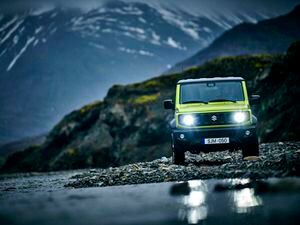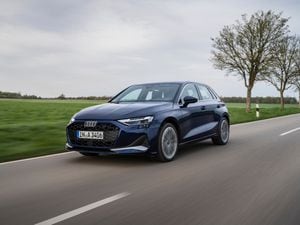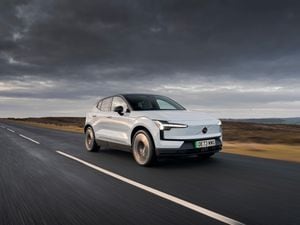First Drive: Suzuki’s Jimny comes back with a bang
Suzuki’s iconic Jimny is back, and it’s more grown-up than ever. Jack Evans heads to Frankfurt to see what it’s like

What is it?
The cult classic returns – it’s the all-new Suzuki Jimny. The previous (and third) generation was built for 10 years, and gained a momentous reputation for being brilliant off-road, incredibly reliable and cheap to buy as well. Now, there’s a new one.
It may follow a similar platform – its chassis is still a ladder frame design, for instance – but a variety of tweaks and touches have been implemented to make this Jimny just a little more grown-up, but no less bullet-proof. We headed out to Frankfurt in Germany to see if it can match its predecessor’s form.
What’s new?
The fundamentals remain delightfully simple. There’s still – as we mentioned – a ladder chassis underneath the whole operation, which gives the Jimny excellent capability off-road and an excellent level of robustness. And while other small off-roaders choose electronics to help when the terrain gets sticky, the Jimny still offers a proper four-wheel-drive system with transfer gear and three-link rigid axle suspension.

There’s a new powertrain – though we’ll come to this shortly – and while the new Jimny is actually shorter than the car it replaces, it’s able to offer up better interior space and passenger legroom thanks to an increase in the front and rear seat hip points. All of these features mean that while the new Jimny is no less capable off-road, it’s a little easier to live with.
What’s under the bonnet?
Underneath the Jimny’s short, snub nose beats a 1.5-litre four-cylinder petrol engine with 101bhp. In regular modes it runs in rear-wheel-drive, sending power to the wheels through a five-speed manual (an automatic will be available from launch, too), and though Suzuki hasn’t quoted any official 0-60mph figures, we’d estimate it’s somewhere just over the 10 second mark.

The whole drivetrain can be switched into four-wheel-drive with a separate shift lever underneath the conventional gear stick. This allows you to pick between two-wheel-drive, four-wheel-drive high gear, and four-wheel-drive low gear – for when the going gets really tough. In terms of economy, Suzuki claims 35.8mpg on the combined cycle (tested under new WLTP regulations) and emissions of 178g/km CO2. Top speed for the manual gearbox-driven car is a dizzying 90mph, but in truth this is a car which isn’t about all-out performance.
What’s it like to drive?
Quite a lot of the issues we had with the old Jimny have been suitably rectified. When on the motorway the Jimny now feels far quieter and relaxing than its predecessor, for instance. There’s still quite a large amount of wind noise generated by the close to vertical windscreen, but the engine noise is isolated well and it sits at just under 3,000rpm when travelling at 75mph (while travelling on a de-restricted German autobahn, we’ll add). Would a sixth cog in the gearbox help the whole affair feel a little more settled-down? Certainly. But as it is, it feels more than happy travelling at higher speeds.
Then there’s the way it goes off-road. Thanks to its low weight and impressive approach and departure angles, the Jimny still manages to tackle terrain which would leave other so-called off-roaders floundering in the mud. It’s very impressive indeed.
How does it look?
Part Mercedes G-Wagen, part Japanese Kei-car, the Jimny manages to look both imposing and cutesy all at the same time. The square proportions make it stand out against ordinary traffic, while the chunky wheelarches and bumpers give it an appearance of a car that really is ready for any adventure. Our test car, finished in ‘Kinetic Yellow’ (designed to be bright enough to stand out in poor weather), certainly turned heads as we ambled through small German villages.

It’s a fitting evolution on the Jimny appearance, and though some throwback design touches remain – the round headlamps with independent indicators being just two – it feels thoroughly fresh and modern, and all the better for it.
What’s it like inside?
The Jimny has been designed to be robust and hard-wearing, and as such we can forgive it for the amount of harder plastics used throughout the cabin. Everything feels rock-solid, however; the grab handle in front of the forward passenger, for instance, has been rubberised and feels as though it’s been built for chilly days out in the fields.

It’s a strange extra, therefore, that given that Suzuki impressed upon us that the cabin controls had been designed ‘to be simple to use with gloves’ that a touchscreen audio volume controller had been fitted – something we’d be certain would have been accessed via a rotary dial.
The standard boot space remains pretty woeful, just as it did in the previous car. With all seats in place there’s little more than a space for the boot door to fit, though with the rear seats laid flat there’s 377 litres to play with – 53 litres more than its predecessor.
What’s the spec like?
Just two specifications will be available from launch – SZ4 and SZ5. Lower-grade cars still benefit from air conditioning, cruise control, Bluetooth connectivity and DAB digital radio. Of course, the full suite of off-road kit is included as standard too, with features such as hill descent control and dual sensor brake support fitted to SZ4 models.

Go up a grade, and you’ll find features such as 15-inch alloy wheels, climate control and a full satellite navigation system bundled in. We’ve yet to find out how much the Jimny will cost from launch however, so we’ll have to wait and see how much value these specifications offer.
Verdict
Right off the bat, the Jimny has managed to encapsulate all that was loved about the previous car while adding better refinement and build quality. It still, as you’d hope, is an utter triumph off-road, shaking off even the most difficult of surfaces and inclines.
Our only real sticking point is the price, or rather the lack of it; if Suzuki pitches this at just a slight premium over the starting price of the older car (around £16,000), then it’ll have a success on its hands. Too much more than that, and the limitations of the Jimny (lack of boot space, being one), could make this a less appealing prospect. We just hope it gets it right.





